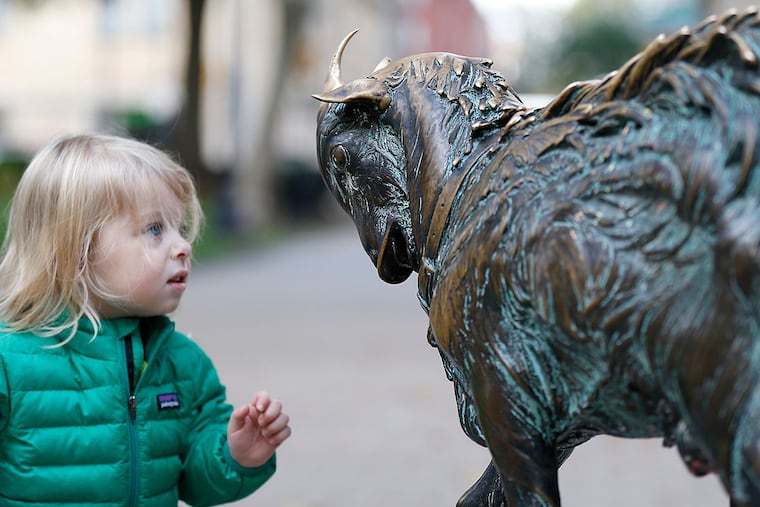Original Rittenhouse Square billy goat to be put in the barn?
Can a goat be loved too much? Maybe so, if the bronze statue of Billy in Rittenhouse Square is any indication.

Can a goat be loved too much?
Maybe so, if the bronze statue of Billy in Rittenhouse Square is any indication.
Created by Philadelphia sculptor Albert Laessle in 1914 and installed around six years later, Billy has withstood the tactile affections of generations of children, who have clambered on, petted, and generally rubbed the animal like a genie capable of conferring endless luck and youth.
All that fevered attention has worn the metal thin, with much of the goat's detail lost, according to Margot Berg, the city's public art director. Any further erosion by tiny fingers could expose dangerous sharp edges, she said.
That's why the city would like to replace Billy with a replica, a bronze cast made from Billy's sibling - also sculpted by Laessle - in Camden (a third Billy sits in the Smithsonian Institution). More intact, the Jersey Billy is nevertheless little known or admired, the price it pays for its relative anonymity in Camden's Johnson Park.
Making the proposition enticing to Berg and others is the offer of an anonymous donor to pay the roughly $19,000 for the casting, thus saving city funds.
The donation provides symmetry to Billy's tale. It was an anonymous benefactor - widely believed to be civic leader Eli Kirk Price II - who bought the statue on the city's behalf in the first place.
Now, these many years later, the original Billy would be corralled and escorted from the park, then put up in a barn, so to speak: an indoor perch in the neighboring Philadelphia City Institute Branch of the Free Library.
The city's Conservation Advisory Committee signed off on the idea. The matter goes to the Philadelphia Art Commission on Wednesday for a final verdict, Berg said.
"This is to be sure there's a Billy goat in Rittenhouse Square for another hundred years," she added. "This is a wise path to take."
Is it, some ask, or is the removal of a historic piece a mistake?
"I love seeing the rubbed sections of the original, which now look gold," said Gayle Christiansen, a Camden City planner well acquainted with the Billys. "Seeing how much people have enjoyed the goat is important as well."
And, Christiansen said, "the sculpture is already sharp," its horns, tail, and some of the hair on its back. A child could still get hurt, she added.
Hauling out the original work "is just crazy," said Susan Gaughan, 71, of Boston, who brought her year-old grandson, Luke, to gaze at Billy on Tuesday. "I spend a lot of time in France. Do you think they remove the art because it's old? I believe in preservation, but this is goofy."
Besides, noted Colombina Valera, monuments coordinator for the New York City Monuments Conservation Program, bronze that's been continually rubbed by children becomes more weather-protected over time, thanks to the oil in people's hands.
All well and good, said Paul Cavanagh, a Rhode Island artist and expert in bronze casting whose works are displayed in the U.S. Capitol, the entry to the Washington Monument, and many other spots. (He owns the original plaster cast of Billy made by Laessle before he created the bronze work.)
But consider that bronze casting is only one-quarter of an inch thick. The laws of physics dictate that, with wear and tear, the surface can eventually disappear. That's what nearly happened to the often-touched foot of St. Peter in the Vatican, and it had to be replaced by a solid bronze piece, "which doesn't even look like a foot at all," Cavanagh said.
And at this point, Billy is being used like a playground apparatus and is developing holes in one of its horns from continual wear, noted Laura Griffith, associate director of the nonprofit Association for Public Art in Philadelphia.
"It's the most-touched work in the city, and it'll only get worse over time," she said, voicing support for the city's desire to replace Billy.
Ultimately, one parent conceded, whether Billy is the original or an ersatz animal will probably have little effect on the children who come to Rittenhouse Square to see it.
"My daughter Audrey loves it," said area resident Monica Petrilli, 34, as her 2-year-old ran toward Billy. "The goat is a focal point. It's great, because all kids gather here."
215-854-4969 @AlfredLubrano